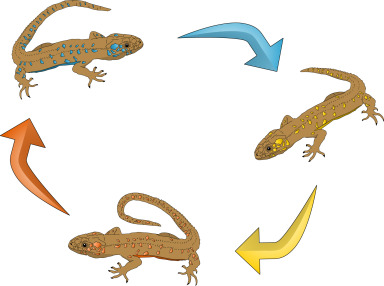
Researchers found that the different morphs had different mating strategies.
The orange morphs are more aggressive. Their strategy is to control large territory and protect many females.
The yellow morphs are sneaky. Their strategy doesn't involve holding territories, but instead try to sneakily mate with unguarded female
The blue morphs are monogamous. They have one partner and are vigilant of them all the time.
From this we can infer that certain morphs are more effective against others. The sneaky yellow morphs can get past the aggressive orange morphs. The blue morphs are more vigilant, and are more effective against sneakers. And the organge morphs are more effective against the blue morphs due to their larger size.

We can assign fitness values to each morph, based on how much of the other morphs are present. For instance the reproductive ability of a orange sneaky morph would be higher, if the number of orange aggressive morphs is large.
A fitness value represents how many offspring an individual have. A larger value represents a larger number of offspring. We can implement this in our model in many ways, but a simple way would be as follow. \[o_{n+1} = o + o \times y\] What this equation means is that the amount of orange morphs in the next generation would be a result of the number of orange morphs in the current generation plus a fraction of the number of blue morphs. A complete version would be \[o_{n+1} = o + o \times b\] \[b_{n+1} = b + b \times y\] \[y_{n+1} = y + y \times o\]We can implement this in our simulation. There may be more accurate ways to model this, but with our barebones assumptions, let's see what happens.
Next